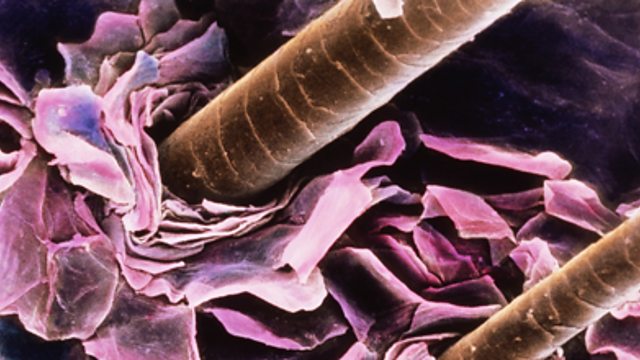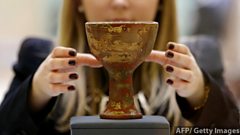Hair, Fur and Cilia
Microscopic tails on cells, hair on the head, fur on animals – why these slender filaments are essential to life. With Philip Beales, Ralf Paus and Adeline de Monseignat.
Hair has always held us captive: a symbol of vitality, or of sexual attraction and youth. But what are its molecular secrets? And what are we learning about those other mysterious filaments: the hair-like cilia attached to almost every living cell? Bridget Kendall asks leading hair loss researcher Ralf Paus, medical geneticist Philip Beales, and artist Adeline de Monseignat whose sculptures of fur and hair look both dead and alive.
Photo: Hair on scalp (coloured scanning electron micrograph) Credit: Science Photo Library
Last on
Clip
-
![]()
The Wonders of Hair
Duration: 00:51
Chapters
-
Philip Beales
The cilium – our inner tail
Duration: 14:10
Adeline de Monseignat
Uncanny hair and fur sculptures
Duration: 08:50
60 Second Idea
Hair massage days
Duration: 05:32
Ralf Paus
How to help stop hair loss
Duration: 11:58
Philip Beales
![Philip Beales]()
Philip Beales is professor of medical genetics at University College London and a clinical scientist at Great Ormond Street hospital. He is also head of the cilia disorders laboratory. A cilium is a slender microscopic hair-like structure that extends like a tail from the surface of all our cells, and is vital for our body's healthy functioning. Professor Beales says the significance of the cilium is reflected in the fact that it is primordial, and ubiquitous in nature, from bacteria in volcano vents to fish, worms and insects. As a specialist in diseases that occur when cilia are not functioning, Professor Beales shares with us his latest research which discovered a link between obesity, diabetes and cilia disorders. Professor Beales is also the co-editor of Ciliopathies: A Reference for Clinicians.
Adeline de Monseignat
![Adeline de Monseignat]() Adeline de Monseignat is a Monegasque sculptor who works with hair and fur. What fascinates her about using these materials is that they are somewhere in between the animate and inanimate, the dead and living, which is why she describes her creations as "creaptures" - a cross between sculptures and creatures. This also highlights a duality she explores in hair and fur: how it attracts and repulses at the same time.Β You can see some of Adeline's sculptures in the gallery on the right of this page.
Adeline de Monseignat is a Monegasque sculptor who works with hair and fur. What fascinates her about using these materials is that they are somewhere in between the animate and inanimate, the dead and living, which is why she describes her creations as "creaptures" - a cross between sculptures and creatures. This also highlights a duality she explores in hair and fur: how it attracts and repulses at the same time.Β You can see some of Adeline's sculptures in the gallery on the right of this page.Ralf Paus
![Ralf Paus]()
Ralf Paus is professor of cutaneous medicine at the University of Manchester and runs one of Europe's leading hair research groups in Manchester, and at the University of MΓΌnster, in Germany. Professor Paus specialises in promoting hair growth. Describing each hair follicle as a hormone factory, Professor Paus believes neurohormones play a vital role in hair growth: these are hormones with neurotransmitters which he has shown that both the brain and the hair follicle are able to produce and are used in the production of hair cells.
60 Second Idea to Change the World: Therapeutic Hair Massage
![60 Second Idea to Change the World: Therapeutic Hair Massage]()
In our 60 second Idea to improve the world, the artist Adeline de Monseignat suggests having events in art galleries where people can go to exchange hair massages. She believes many of us enjoy hair massages, but rarely have a chance to experience them – except very occasionally at the hairdressers. She feels they would be beneficial in helping people relax and would stimulate hair growth.
Broadcasts
- Sat 3 May 2014 21:06GMTΒι¶ΉΤΌΕΔ World Service Online
- Mon 5 May 2014 02:06GMTΒι¶ΉΤΌΕΔ World Service Online
Do you think political or business leaders need to be charismatic? Or do you prefer highly competent but somewhat stern people?
Podcast
-
![]()
The Forum
The programme that explains the present by exploring the past








